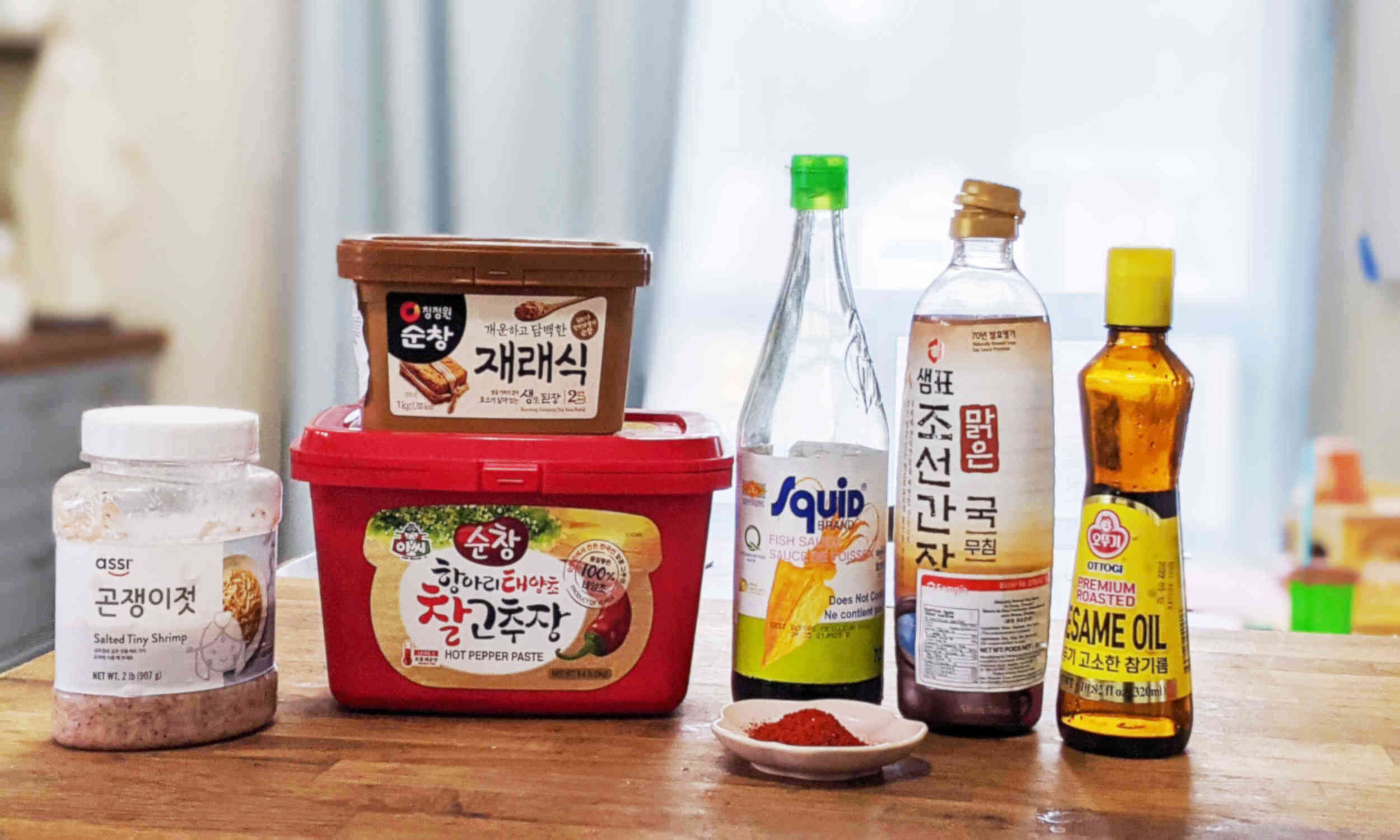How to Store Korean Ingredients
Basic korean ingredients
DO KOREAN INGREDIENTS GO BAD?
With the exception of Korean Salted Shrimp, all Korean cooking ingredients can be stored in a cool, dark place like the kitchen cupboard. However, because most of us purchase factory-made products, it is safer to follow manufacturer recommendations and store them in the fridge. Natural, homemade products may continue to ferment and age like a fine wine, but it isn’t so with commercial products. You will sometimes see a statement to consume within X months. This is really in reference to retaining that initial aroma and flavour when you first open it- hence the wording “best before”. It will taste best during that time, but doesn’t necessarily mean you need to throw it out if you do exceed that period.
You may not feel like cooking Korean food on a daily basis, but it sure is a hassle when the craving hits and you have to go to the store to buy all the necessary Korean ingredients. Don’t waste money with these essential components going bad by following these storage tips.
HOW TO STORE GOCHUGARU (KOREAN SPICY RED PEPPER POWDER/FLAKES)
GOCHUGARU keeps longest in the freezer. Transfer some to a smaller container to keep in a cupboard or fridge for easy access. You can also use it straight from the freezer if that works for you. The primary sign that may mean it’s time for a replacement would be a change in colour. Like any spice, it will turn brown and lack flavour over time. If it’s all brown, it’s a sure sign to buy a new bag.
We used GOCHUGARU that had turned brown to make kimchi and ruined it. That was a sad day. We did make stew with it and added fresh GOCHUGARU so it wasn’t a complete fail.
GOCHUGARU will keep in the freezer for 1-2 years. As long as the flavour is still there, it honestly doesn’t spoil in the freezer.
HOW TO STORE FISH SAUCE
Keep in a cool, dark place. With its sky-high salt content, fish sauce is the ingredient you can worry least about spoiling. If for some reason you haven’t used it for 5+ years, you may notice the colour changing from clear brown to a cloudier liquid. The taste might have changed a bit but it’s still probably fine to consume it. #zombiefood.
HOW TO STORE SAEWOO JUT (KOREAN SALTED SHRIMP)
Korean salted shrimp needs to be kept in the fridge (it’s sold as a refrigerated product). The best before date is about 1 year. If you notice a yellowing discoloration, it may be because the shrimps are not completely submerged. Scoop out the discoloured bits and press the rest down underneath the liquid.
Many home cooks swear by keeping it in the freezer. It will not freeze at all and is quite easy to use as you need it. Another thing to keep in mind is that you should always ensure using only clean and dry utensils when scooping out the contents to keep from contamination.
If it’s got a terrible smell that is not like the usual stink of salted shrimp, it’s time to toss it.
HOW TO STORE SOY SAUCE
Keep soy sauce in a cool, dark place. You may want to follow recommended guidelines with store-bought soy sauce which is to keep in the fridge once opened. There is an expiry printed on the bottle, but it should last a very long time (1-2 years) although manufacturers have been suggesting to consume within 6 months for best flavour.
Although it’s true that it will start lose some flavour once opened, it does so very slowly. It’s such a heavily salted product, it’s doubtful you will have problems with soy sauce.
It’s time to get a new bottle if you see things floating in it. The most common ways that soy sauce will go bad is if you keep it somewhere that’s too warm (near the stove during the summer) or get it contaminated with bacteria (while taste testing or touching the opening of the bottle).
HOW TO STORE CHAMGIRUM (TOASTED SESAME OIL)
Store CHAMGIRUM with your other oils in a cool, dark location or in the fridge. There is an expiry date listed on the bottle but if it still smells fine, it should be okay to use. Toasted sesame oil is said to be best consumed within 12 months.
Going by smell (it will smell rancid and very off-putting) is a reliable indicator of freshness.
HOW TO STORE GOCHUJANG (KOREAN RED PEPPER PASTE)
There is an expiry date on the tub you can look for reference. However, if the GOCHUJANG still looks and smells like when you first opened it, it’s good to use. Keep in the fridge to make it last fresh longer, but many Koreans keep it in a cool, dark place like the kitchen cupboard.
If you see white mold developing on top, scrape off that layer. It may also develop a dark red crust if you don’t use it regularly- if the paste beneath is still bright red and of good consistency, you can also still use it.
Homemade GOCHUJANG can go a long time and will continue to ferment and develop better flavour, This is not the case with commercially manufactured GOCHUJANG. It does have preservatives added, but it may be best to keep in the fridge and consume by (or nearby) the best before date listed- usually 2 years.
HOW TO STORE DOENJANG (KOREAN FERMENTED BEAN PASTE)
Keep in a cool, dark place or in the fridge. DOENJANG may also develop white mold but like GOCHUJANG, you would just scrape it off the top. It may also develop a darker coloured crust which can happen once exposed to air. That’s simply due to exposure to oxygen which dries it out and changes the colour but is still safe to eat. You can just mix it back in, although I usually just scrape it off and dispose of it. I would follow the best before date for a commercially-made product (at the same time, if it looks and smells fine for a few months after the date, I would still use it).
HOMEMADE SOY SAUCE, GOCHUJANG AND DOENJANG
Most people will be buying their Korean ingredients online or from a Korean grocery store. If you are lucky enough having someone making Korean soy sauce, GOCHUJANG or DOENJANG from scratch, storage tips differ slightly. These are fermented products that only get better with age, just like vintage wine.
Aged soy sauce (and less common but GOCHUJANG and DOENJANG as well) only gets better with time. You will find smaller artisanal batches that have been aged for 10 years or more selling for a premium price. Like sourdough starters that are 100+ years old, there are very old soy sauces in Korea that are thought to help cancer patients. They take a dose with a spoon, just like medicine.
I would really think twice before throwing out a homemade soy sauce, GOCHUJANG or DOENJANG because of fears it has gone bad. The only thing you may want to do is keep them in glass containers (if they are in plastic containers) or get serious about it and invest in an HANGARI/ONGGI (Korean clay pot).
BONUS STORAGE TIPS FOR GOCHUJANG AND DOENJANG:
If you love these ingredients but find you really don’t use them often at all, try the baby food trick. Get an ice cube tray to use specifically for this or line each cube spot with plastic wrap. Spoon just enough paste into each and freeze them. Once frozen, pop them in a ziploc bag and keep them without worries of spoilage. Thaw some out in the fridge the night before, and you can have Korean ingredients at hand even when you only feel like cooking with it occasionally.
As with anything, use your judgement. If it smells foul or you feel uncomfortable eating it, throw it out.
Happy Korean Cooking!

